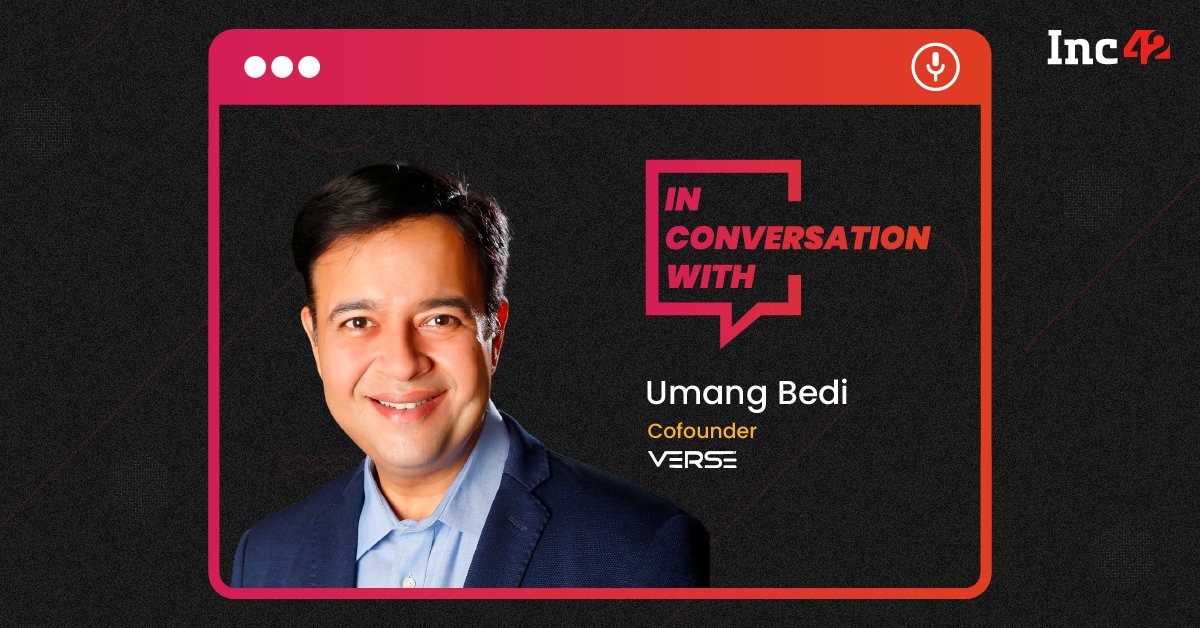In an interaction with Inc42, Umang Bedi of VerSe Innovation (Josh’s parent company) discussed some major trends in digital advertising and how early stage startups can benefit from them
Influencer marketing, value-based marketing and user-generated content are the key advertising trends in 2022, he said
Bedi warned brands against intrusive advertising tactics that can hinder user experience
Globally, the explosion of short-form video formats such as TikTok, Instagram Reels and YouTube Shorts has revolutionised digital marketing. Many brands, including legacy players like Nike and Adidas, actively leverage these formats as part of their core marketing strategy. This is not surprising as ‘going viral’ enables companies to boost brand awareness, drive engagement and create a buzz around new campaigns and launches.
In India, the scenario is not too different. Homegrown short-video apps are soaring high on traction, filling the market gap created since July 2020 when the popular Chinese app TikTok was banned over alleged threat to national security due to user data ‘misuse’. ByteDance-owned TikTok was not alone. As many as 58 other Chinese apps were banned by the government, creating a huge content vacuum, and there was a sweeping impact on the business community.
According to consulting firm RedSeer, local players like Josh, Moj, MX Takatak and Roposo clocked over 200 Mn monthly active users (MAU) last year and have more than 4x content creators than TikTok did in India before the ban. What’s more? The short-format video market is estimated to breach 600 Mn users by 2025.
Besides the fast-growing affordable smartphone market and fast-spreading internet penetration across the country (61% currently), the credit for the rise of these platforms goes to the massive surge in vernacular digital content consumed by suburban and rural users. Statistically, about 90% of the country’s new internet users consume content in vernacular languages.
The short-video aggregation platforms have also opened the floodgates for new-age advertising in sync with the global practices, utilising user-generated content, live streaming, in-app purchases and video commerce. Brands can leverage these techniques or opt for simpler ones like hashtag challenges or influencer marketing, which are cost-effective and have a shareability quotient.
Saying that, the short video ad market is still at its nascent stage as RedSeer pointed out. But its prospects look promising. According to the consulting firm, short form apps can take up to 20% of the digital ad pie, which is pegged to reach $10 Bn by 2025.
Given the enormous headroom for targeted advertising via short-video formats, Indian startups in this space are now in the spotlight as they have the potential to disrupt digital advertising. But the question is: Can new-age Indian brands rack up millions of pageviews or make users dance in viral hashtag challenges like Nike?
To decode some of the biggest trends in digital advertising and address the common challenges early stage consumer startups face in delivering the most effective digital ad campaigns, Inc42 caught up with Umang Bedi, cofounder of VerSe Innovation, the parent company of Josh.
Below are the edited excerpts of the interview.
Inc42: What kind of advertising challenges are faced by early stage startups on shoestring budgets?
Umang Bedi: Finance is a major challenge for early stage companies. Hence, they should always have a pre-planned budget for their campaigns and a clear understanding of the goals to be achieved. Failing to draw the attention of the right audience is another challenge, as many startups fail to choose proper communication channels.
Staying updated about the latest marketing trends is the key. My advice to early stage startups is: Conduct a thorough survey of your campaign performance and track your marketing ROI (return on investment) to measure the success of your advertisements.
Inc42: Right now, what are the most significant advertising trends in the digital space?
Umang Bedi: Today, consumers don’t want someone to sell them a product randomly. There has to be a story behind it. Influencer marketing plays a critical role in communicating the ‘real’ story behind a product. So, I believe startups should leverage it on both content and video platforms. Interactive content is also gaining momentum across popular formats such as gamification, quiz, survey and live chat.
Also, consumers want to feel good about their purchases and look for meaningful relationships with brands. Value-based marketing is a way to appeal to a customer’s values and ethics, shifting the focus from a typical product-centric approach to a customer-centric one. These trends will continue to shape digital advertising in 2022.
Inc42: How can startups come out with effective campaigns without compromising on user experience?
Umang Bedi: Nowadays ads are becoming increasingly pervasive as consumers are bombarded with irrelevant offers, pop-ups and annoying autoplay videos. Running such intrusive and unwelcomed ad formats can lead to consumer frustration. Non-intrusive advertising is a better way to reach the desired audience as these formats are passive and allow consumers to reach out to the brands themselves. This type of advertising is also directed towards a very specific target audience. Thus, personalisation gives you higher returns even though your reach is lower.
Inc42: What are the advantages of vernacular, hyperlocal advertising?
Umang Bedi: Providing content in local languages is a vital strategy for companies aiming to tap into a new user base. This is because around 70% of Indians find local language digital content more reliable. Moreover, 88% of vernacular internet users are more likely to respond to digital advertisements in their local languages instead of ads in English.
Brands are also realising the importance of a hyperlocal approach as this content format appeals to the masses. It has become an important tool for brands as they strive to engage with their audiences authentically and effectively.
Inc42: Short-video apps have taken off in a big way in India, especially in Tier 2 and Tier 3 locations. How can brands leverage these platforms to reach potential customers?
Umang Bedi: Now that short video apps are gaining popularity across India, brands can engage with their audiences more creatively and effectively. User-generated content is a great way to kick off your video marketing initiative, as these videos are both engaging and cost-effective. This medium has the potential to strengthen your online community, help attract varied consumers and reach a wider audience in ways which were not possible before.
Inc42: Tell us more about the short-video advertising trends that brands should watch out for in 2022?
Umang Bedi: Well, user-generated content is one of the most trusted forms of marketing on short-video apps, and it will continue to thrive this year. Also, influencer marketing is a tried and tested strategy to reach new audiences.
Brand-induced campaigns and ‘challenges’ are great ways to grab eyeballs, build community and engage with users. Likewise, brands should create product teasers, explainers and educational videos that can go viral and create a buzz for the brand.
Inc42: How can Josh help the brands looking for cost-effective and personalised advertising?
Umang Bedi: Our strength lies in technology, content and personalisation. We can recommend the next piece of content that is likely to gain maximum user engagement. Josh’s AI-based filters, effects and tools augment the content creation process – making it easy, seamless and fun for our users and the brands running content-based campaigns on our platform.










